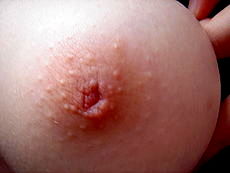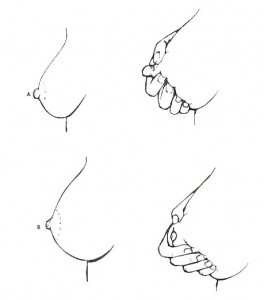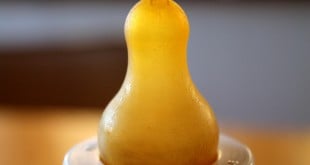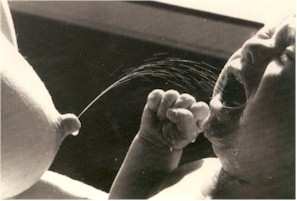 Mother’s nipples come in many shapes and sizes. While most nipples protrude and are easy for baby to grasp, there are some variations in size and shape that make it difficult for them to nurse successfully. In order for a baby to nurse effectively, he must be able to grasp the nipple and stretch it forward and upward against the roof of his mouth. Flat or inverted nipples may make it difficult for your baby to nurse.
Mother’s nipples come in many shapes and sizes. While most nipples protrude and are easy for baby to grasp, there are some variations in size and shape that make it difficult for them to nurse successfully. In order for a baby to nurse effectively, he must be able to grasp the nipple and stretch it forward and upward against the roof of his mouth. Flat or inverted nipples may make it difficult for your baby to nurse.
In women who are pregnant for the first time, it is very common for the nipple to not protrude fully. About one third of mothers will experience some degree of inversion, but as the skin changes and becomes more elastic during pregnancy, only about ten percent will still have some inversion by the time their baby is born. The degree of inversion is likely to become less with each subsequent pregnancy.
Because your baby forms a teat not just from the nipple but also from the surrounding breast tissue, most inverted or flat nipples will not cause problems during breastfeeding. Some types of flat or inverted nipples will cause problems, however, and there are some steps you can take to help correct the problem both before and after the baby is born.
 The first thing you need to do is determine whether your nipples really are flat or inverted. You can do this while you are pregnant by performing a simple “pinch” test: Hold your breast at the edge of the areola between your thumb and index finger. Press in gently but firmly about an inch behind your nipple. If your nipple protrudes, that’s great. If it does not protrude or become erect, it is considered flat. If it retracts or disappears, it is truly inverted. Nipples that are severely flat or inverted will not respond to stimulation or cold by becoming erect. If you perform the pinch test and your nipples protrude, they aren’t truly inverted and will probably not cause any problems when you nurse your baby.
The first thing you need to do is determine whether your nipples really are flat or inverted. You can do this while you are pregnant by performing a simple “pinch” test: Hold your breast at the edge of the areola between your thumb and index finger. Press in gently but firmly about an inch behind your nipple. If your nipple protrudes, that’s great. If it does not protrude or become erect, it is considered flat. If it retracts or disappears, it is truly inverted. Nipples that are severely flat or inverted will not respond to stimulation or cold by becoming erect. If you perform the pinch test and your nipples protrude, they aren’t truly inverted and will probably not cause any problems when you nurse your baby.
A truly inverted nipple is caused by adhesions at the base of the nipple that bind the skin to the underlying tissue. While the skin does become more elastic during the third trimester of pregnancy in preparation for nursing, some of the cells in the nipple and areola may stay attached. Sometimes the stress of vigorous nursing will cause the adhesion to lift up rather than stretching or breaking loose, and this can cause cracks in the nipple tissue and pain for the mother.
Because the breasts function independently of each other, it is not unusual for a mother to have one flat or inverted nipple, or to have one nipple that protrudes more than the other. For the same reason, it is not unusual for a mother to produce more milk from one breast than the other.
 The degree of inversion varies greatly, ranging from the nipple that doesn’t protrude when stimulated, but can be pulled out manually, to the severely inverted nipple that responds to compressions by disappearing completely. (See illustrations).
The degree of inversion varies greatly, ranging from the nipple that doesn’t protrude when stimulated, but can be pulled out manually, to the severely inverted nipple that responds to compressions by disappearing completely. (See illustrations).
How much difficulty a flat or inverted nipples presents to a nursing baby depends on the degree of inversion as well as the baby himself. If you have a strong, healthy, full-term, vigorous nurser, he may be able to draw out the nipple and dislodge the attachments with relative ease.
The Hoffman Technique is a manual exercise that may help break adhesions at the base of the nipple that keep it inverted. Place the thumbs of both hands opposite each other at the base of the nipple and gently but firmly pull the thumbs away from each other. Do this up and down and sideways. Repeat this exercise twice a day at first, then work up to five times a day. You can do this during pregnancy to prepare your nipples, as well as after your baby is born in order to draw them out.
Gentle manual or oral stimulation of your nipples can be a part of lovemaking, and may encourage your nipples to protrude. Your partner will enjoy helping you prepare your nipples for nursing.
Many moms are not aware of the difference between ‘nipple shields’ and ‘breast shells’, but the two are very different. Breast Shells consist of two pieces of rigid plastic: a dome and a base that fit together with a space through which the nipple protrudes, and are worn under a bra They are worn only between feedings, and not while the baby nurses. For many years, they were recommended for use during the last few months of pregnancy because it was believed that the gentle constant pressure around the base of the nipples helped release the adhesions that kept the nipple from everting. However, research has shown that they don’t to make much difference in changing the shape of the nipple so, so their use is seldom recommended.
After your baby is born, you can use a breast pump to draw out a flat or inverted nipple immediately before putting your baby on the breast. Pumping can also be useful in order to break the adhesions under the skin by applying uniform pressure from the center of the nipple. If the nipple is truly inverted, (which is usually present in only one nipple rather than both), you may need to use the pump to provide stimulation and supplement with your breast milk. This is especially the case if the inversions are present in both nipples. Usually, after the first few feedings the baby’s vigorous sucking will exert negative pressure and help the tissue protrude. With both flat and inverted nipples, the baby will become better at grasping and drawing the nipple into his mouth as he gets bigger and stronger.
If your nipples are flat or inverted, it is helpful if you have help from a Lactation Consultant if possible during the first feedings, as these are likely to present the most problems. Useful techniques include:
- Stimulating your nipple. Unless it retracts completely, grasp the nipple and roll it between your thumb and index finger for 30 seconds, then touch it with a moist, cold cloth immediately before offering it to your baby. A disposable nursing pad that is dampened and put in the freezer makes a great ice pack to help the nipple evert immediately before nursing.
- Pulling back on the areola before you latch the baby on. Support your breast with your thumb on top and your other fingers underneath, and pull back on the breast toward the chest wall. This will help the nipple protrude.
- Using a nipple shield. This is a thin, flexible silicone nipple with holes in the end that fits over your nipple during feedings. Nipple shields got a very bad reputation years ago when they were made out of thick rubber, and caused a significant decrease in the mother’s milk supply. They were handed out freely to new mothers in order to ‘reduce nipple soreness‘ or to get babies to nurse at the breast. Under these circumstances, they created more problems than they solved. Modern nipple shields are made from a clear, thin layer of silicone, which means that more stimulation reaches the areola, and the reduction of milk volume is minimized.
While nipple shields should only be used when a lactation professional recommends them and supervises their use, they can be helpful in certain situations. One of the situations in which a nipple shield can be useful is in helping an infant latch on to a severely inverted or flat nipple, especially when other measures described above have failed. Mothers who use the shield should be instructed on how to wean the baby off the shield as soon as possible, and should weigh their baby frequently to assure adequate milk intake. For many mothers, use of a shield is the first step in getting her baby to nurse at the breast, and may mean the difference between continuing to nurse or weaning. The mother’s ability to feel her baby sucking at her breast may encourage her to continue nursing after other attempts have failed. She needs to be encouraged to periodically put her baby on the breast without the shield until she is able to discontinue its use entirely. If the baby will take one breast without the shield, she should nurse him on that breast at each feeding, and use the shield only if the baby won’t take the other breast without it. While some babies move quickly from nursing with the shield to nursing without it (sometimes after only one or two feedings) other babies have to be weaned from it gradually. My niece, who had one normal nipple, and one that was severely inverted, used the shield on and off for several months. She monitored her baby’s weight gain carefully, and he is now happily nursing (without the shield) at the age of 18 months. Considering the severity of her inversion, I am not sure that her baby would have ever been able to nurse on that breast without the use of the shield.
During your initial feedings, your baby may be able to open his mouth wide enough and suck vigorously enough to draw the nipple far into his mouth and close his gums on the areola, so the flat or inverted nipple may not present a major problem. Having someone to help you with latch on and positioning can be very helpful.
You will want to nurse as soon as possible after birth, and every 2-3 hours after that. You want to avoid engorgement, because breast swelling can cause the nipples to flatten out, making them more difficult to grasp.
During the initial learning period of breastfeeding, try to avoid the use of any artificial nipples. Supplement with alternative feeding methods, because the baby who is learning how to nurse, especially on a nipple that isn’t the ideal shape for nursing, is more likely to become nipple confused. See article Introducing Bottles and Pacifiers to the Breastfed Baby to get more detailed information on alternate feeding methods.
If feedings become stressful, stop and comfort your baby. Try rocking, swaddling, walking, giving him your finger to suck, or offer him some expressed milk or water or until he settles down. You want him to associate feedings with positive feedback, not negative. Supplementing your baby or using a nipple shield temporarily is preferable to having a baby who screams every time you open your nursing bra.
Many mothers with flat or inverted nipples experience some degree of nipple soreness. You may experience soreness as the nipple is drawn into the baby’s mouth, and the adhesions are stretched or broken. If the nipple draws back into the baby’s mouth during or immediately after feedings, moisture may become trapped and contribute to soreness. Try patting the nipples dry after feedings and apply a thin coating of lanolin or olive oil.
If the soreness lasts for more than a week or two, you may need to use a high quality pump (See article Pumping and Storing Breastmilk ) to help maintain your milk supply. When a nipple is severely inverted, the baby may compress the nipple buried inside the tissue, rather than the milk sinuses underneath the areola. The sucking action of the pump pulls out the center of the nipple uniformly, rather than compressing the areola. This can help gradually break the underlying adhesions.
If both nipples are severely inverted (which is not usually the case) you may need to double pump every 2-3 hours and feed your baby with an alternative method until the adhesions are broken and the nipples protrude. This is a situation in which renting a pump may really be worth it. In some extremely rare cases, the baby never successfully goes on the breast and you may need to continue pumping and feeding your expressed breast milk by bottle.
Usually, only one nipple is inverted and one breast is easier for the baby to grasp. In this case, you may want to feed on the ‘good side’ while you pump the other breast until the adhesions are loosened. You can feed the baby the milk you expressed on the inverted side after nursing on the other breast.
Some mothers can draw their inverted nipples out with just one pumping session. Others may need to continue pumping for days, weeks, or even months, depending on the degree of inversion and the baby’s sucking patterns. If the nipple inverts again during pauses in the baby’s feeding, you may need to stop and pump again for a few minutes and then put him back on the breast. In almost all cases, the adhesions will loosen and the baby will be able to nurse effectively as he grows bigger and stronger and becomes more efficient at nursing.
In almost all cases, the adhesions will loosen and the baby will be able to nurse effectively as he grows bigger and stronger and becomes more efficient at nursing, whether you invest in gadgets or not. Remember that the baby doesn’t ‘nipple feed’- he breastfeeds. Once he is able to draw the nipple into his mouth, the shape of it doesn’t matter much at all.
Babies grow unbelievably fast, and his tiny mouth will ‘grow into a large/ flat/ or inverted nipple before you know it. Once the nipple everts consistently, it seldom inverts again. Also, inverted nipples are much less common with second babies. Their older sibling seem to have paved the way, and pulled out the nipples for their baby brother or sister and making everyone in the family much happier!
Anne Smith, IBCLC
Breastfeeding Basics
(Edited September, 2019)
*Please Pay It Forward*
If you found any of the information in this article, helpful, please consider making a small donation to my favorite cause – Project Pets: Spay, Neuter, Love – all volunteer, non-profit organization that provides free spay and neuter services for homeless rescue dogs and cats…because every baby deserves a home, whether they have two legs or four! To find out more, visit Project Pets on Facebook.
While you are pregnant, perform a simple “pinch” test: Hold your breast at the edge of the areola between your thumb and index finger. Press in gently but firmly about an inch behind your nipple. If your nipple protrudes, that’s great. If it does not protrude or become erect, it is considered flat. If it retracts or disappears, it is truly inverted.
 Breastfeeding Basics
Breastfeeding Basics





